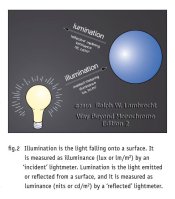Ray Rogers
Member
Normally, I use a Pentax Sotmeter for reflected metering or a Minolta (forgot exact name) for incident light readings...
However, I currently find myself wanting to measure light in such a way as to indicate the approach of a constant given amount of light with a light source that is inconsistent... exposures are quite long so what this amounts to is a meter that will tell me the exposure deficiency remaning in sec/minutes... it needs to accommodate (calculate?) on the fly and adjust its indication according to the variable light that meets the sensor.
Not exactly sure what I need.
Not even sure what I need to measure... Lux, Lumens?
Certainly not sure what device out there could do this sort of job...
Can your meter do this?
However, I currently find myself wanting to measure light in such a way as to indicate the approach of a constant given amount of light with a light source that is inconsistent... exposures are quite long so what this amounts to is a meter that will tell me the exposure deficiency remaning in sec/minutes... it needs to accommodate (calculate?) on the fly and adjust its indication according to the variable light that meets the sensor.
Not exactly sure what I need.
Not even sure what I need to measure... Lux, Lumens?
Certainly not sure what device out there could do this sort of job...
Can your meter do this?






